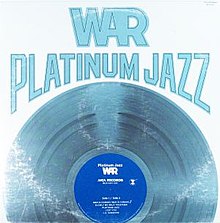Platinum Jazz (album)
| Platinum Jazz | ||||
|---|---|---|---|---|
 |
||||
| Studio album by War | ||||
| Released | 1976 | |||
| Genre | Jazz, R&B | |||
| Length | 79:36 | |||
| Label | Blue Note/United Artists | |||
| Producer | Jerry Goldstein with Lonnie Jordan and Howard Scott | |||
| War chronology | ||||
|
||||
Platinum Jazz is a double album, the ninth studio album by War, released on Blue Note Records in 1976.
The album is an unusual entry in War's discography in several aspects. Its first half is new material, while its second half is a compilation of tracks from previous albums. It is also the only record they made for Blue Note, a jazz label, which was then owned and controlled by their current label at the time, United Artists Records, so it was not a matter of changing labels or going outside of contract. And it is their first album to put an emphasis on instrumental jazz-based music, although some tracks have vocals. This album was apparently Blue Notes first Platinum Disc selling album.
A single from the album was issued, also on Blue Note: "L.A. Sunshine" backed with "Slowly We Walk Together"; both are edited versions. The Album was released as re-issue in UK, on Island Records, as Platinum Funk and as a single album with tracks as Side 1 - War is Coming War is Coming, I got you, L.A.Sunshine (Shortened to 8.40 from original 11.52) Side 2 River Niger, Slowly We Walk Together, Platinum Jazz
The album was packaged as a companion disc to War's Greatest Hits album, and like that album, sports a cover showing a picture of the record itself, in the form of a platinum disc award (while the Greatest Hits cover showed a gold disc; but the actual records within both covers were on regular black vinyl). The cover was printed using metallic silver ink. Cover design concept is credited to Lee Oskar. The record labels on the cover resemble the actual record's labels, but are not an exact match, as the front cover label lists all tracks from sides one and two, and the back cover lists sides three and four, which is not done on the actual labels. (Note that the cover illustration shown here is from a reissue on MCA Records - whose successor Universal Music Group now owns Blue Note - as issued in Canada, and the cover's label design has been modified to replace the Blue Note logo with MCA. Furthermore, the records within this edition have labels that do not match the blue labels on the cover, the records having MCA's regular rainbow-on-black design. For CD reissue, the cover was further modified to show a logo for Avenue Records.) There are some other trivial inaccuracies in the picture: the records have no centre hole, the photo of the record has been mirror reversed (as seen from the run-out groove), and the matrix number (which is the actual album's matrix, and not mirror reversed) is inscribed over top of the run-out groove, which is never done (at least not deliberately) on actual records.
...
Wikipedia
